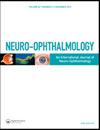Neuro-Ophthalmic Literature Review
IF 0.8
Q4 CLINICAL NEUROLOGY
引用次数: 0
Abstract
Neuro-Ophthalmic Literature Review David A. Bellows, John J. Chen, Hui-Chen Cheng, Panitha Jindahra, Collin McClelland, Michael S. Vaphiades, and Xiaojun Zhang The Medical Eye Center, Manchester, New Hampshire, USA; Departments of Ophthalmology and Neurology, Mayo Clinic, Rochester, MN, USA; Department of Ophthalmology, Taipei Veterans General Hospital, Taipei, Taiwan; Department of Ophthalmology, School of Medicine, National Yang Ming Chiao Tung University, Taipei, Taiwan; Department of Neurology, Mahidol University, Bangkok, Thailand; Department of Ophthalmology, University of Minnesota, Minneapolis, MN, USA; Departments of Ophthalmology, Neurology, and Neurosurgery, UAB Callahan Eye Hospital, Birmingham, AL, USA; Department of Neurology, Ohio State University Medical Center, Ohio, USA; Department of Neurology, Beijing Tongren Hospital, Capital Medical University, Beijing, China Oral fluorescein angiography for the diagnosis of papilloedema versus pseudopapilledema in children Elhusseiny AM, Fong JW, Hsu C, Grigorian F, Grigorian AP, Soliman MK, et al. Oral fluorescein angiography for the diagnosis of papilloedema versus pseudopapilledema in children. Am J Ophthalmol 2023;245: 8–13. This study was designed to determine if the use of oral fluorescein angiography is accurate and safe in differentiating papilloedema from pseudopapilloedema in paediatric patients. Two masked specialists (a paediatric ophthalmologist and retina specialist) reviewed the oral fluorescein angiogram images of 45 patients (90 eyes). They evaluated the optic discs and assigned them to three categories: leakage; no leakage; or “borderline” leakage of fluorescein, at least 30 minutes following ingestion of the medication. The determinations made by the masked observers were then compared with the final clinical diagnosis. There was excellent interobserver accordance in grading the images. Oral fluorescein angiography was found to be safe with no ocular, systemic or allergic reactions. The accuracy, however, was suboptimal with only 62 to 69% of images accurately differentiating papilloedema from pseudopapilloedema. However, the sensitivity at detecting leakage increased with the severity of disc swelling and the observers correctly identified papilloedema in 89% of patients who had Frisén grade 2 or 3 swelling. David Bellows Enhanced depth imaging may be the new gold standard for detecting optic disc drusen Youn S, Mfe B, Armstrong JJ, Fraser JA, Hamann S, Bursztyn L. Am J Ophthalmol. 11 December 2022: S0002-9394(22)00485–8. doi: 10.1016/j.ajo.2022. 12.004. Online ahead of print.神经眼科文献综述
David A. Bellows, John J. Chen,程慧琛,Panitha Jindahra, Collin McClelland, Michael S. Vaphiades, Xiaojun Zhang美国曼彻斯特医学眼科中心;美国明尼苏达州罗彻斯特市梅奥诊所眼神经内科;台北荣民总医院眼科,台湾台北;国立阳明交通大学医学院眼科,台湾台北;泰国曼谷玛希隆大学神经内科;明尼苏达大学眼科,明尼阿波利斯,MN,美国;UAB Callahan眼科医院眼科、神经内科和神经外科,伯明翰,AL,美国;美国俄亥俄州俄亥俄州立大学医学中心神经内科;口服荧光素血管造影诊断儿童乳头状水肿与假性乳头状水肿Elhusseiny AM, Fong JW, Hsu C, Grigorian F, Grigorian AP, Soliman MK等口腔荧光素血管造影诊断儿童乳头状水肿与假性乳头状水肿。中华眼科杂志,2009;24(3):391 - 391。本研究旨在确定使用口服荧光素血管造影在鉴别儿科患者乳头状水肿和假性乳头状水肿时是否准确和安全。两名蒙面专家(一名儿科眼科医生和一名视网膜专家)审查了45名患者(90只眼睛)的口腔荧光素血管造影图像。他们对视盘进行了评估,并将其分为三类:渗漏;无渗漏;或在服药后至少30分钟出现荧光素“边缘性”渗漏。然后将蒙面观察员所作的决定与最终的临床诊断进行比较。在对图像进行分级时,观察者之间的一致性非常好。口服荧光素血管造影是安全的,没有眼部、全身或过敏反应。然而,准确度是次优的,只有62%到69%的图像能准确区分乳头状水肿和假乳头状水肿。然而,检测渗漏的敏感性随着椎间盘肿胀的严重程度而增加,观察人员在89%的fris 2级或3级肿胀患者中正确识别了乳头状水肿。杨建军,张建军,李建军,等。深度增强成像技术在视盘病变诊断中的应用[J] .中国眼科杂志,2016,31(2):559 - 559。doi: 10.1016 / j.ajo.2022。12.004. 先在线,后印刷。
本文章由计算机程序翻译,如有差异,请以英文原文为准。
求助全文
约1分钟内获得全文
求助全文
来源期刊

Neuro-Ophthalmology
医学-临床神经学
CiteScore
1.80
自引率
0.00%
发文量
51
审稿时长
>12 weeks
期刊介绍:
Neuro-Ophthalmology publishes original papers on diagnostic methods in neuro-ophthalmology such as perimetry, neuro-imaging and electro-physiology; on the visual system such as the retina, ocular motor system and the pupil; on neuro-ophthalmic aspects of the orbit; and on related fields such as migraine and ocular manifestations of neurological diseases.
 求助内容:
求助内容: 应助结果提醒方式:
应助结果提醒方式:


